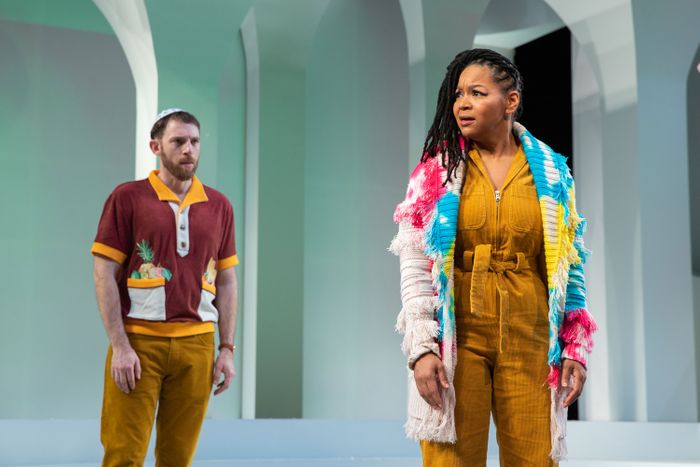
In Greek and Roman myth, and especially in Ovid’s Metamorphoses, humans transform into other beings at climaxes of ambition, emotion and violence. Arachne, after besting Athena in weaving, becomes a spider; Procne and Philomena, getting revenge for rape, become birds; Daphne, trying to escape Apollo, becomes a tree. Agnes Borinsky’s The Trees takes the opposite approach. In her lovely inverted pyramid of a play, a brother and a sister take root in a public park right at the start, for no obvious reason other than they got a little drunk and wistful and fell asleep. An extended denouement follows. Once you have the trees, what else takes root?
The siblings, Sheila (Crystal Dickinson) and David (Jess Barbagallo), are bemused by their sudden arboreal state. “Will anyone notice?” says Sheila, who is visiting David in Connecticut from Seattle. “Should I call the airline?” They stay put, and eventually friends and not-quite friends arrive. Charlotte (Becky Yamamoto) brings them supplies from Target while chattering on about her own needs. David’s supercilious boyfriend Julian (Sean Donovan) checks in, decides this is all simply too much, and breaks up with him. Meanwhile, other hangers-on appear: a vendor (Sam Breslin Wright) looking to make a buck off of gawkers, a rabbi (Max Gordon Moore) with a fondness for Sheila, and Sheila and David’s grandmother (Danusia Trevino) who promises in Polish to do incantations to protect them from wolves.
So an ad hoc community forms around the human trees, nearly unintentionally. Director Tina Satter (of Is This a Room) keeps the action in the realm of cheerful absurdity, matching the diaphanous feeling of Borinsky’s script. Dickinson and Barbagallo stand at the center of Parker Lutz’s set, and they descend into the stage as they take root, and subsequently rise or sink in keeping with the siblings’ emotional state. Sheila amusingly drops away from a conversation she wants to avoid. Thankfully for the actors, whose stamina I started to worry about, they also sometimes sit on stools. The production’s style is cutesy to the point of feeling synthetic: Enver Chakartash’s supersaturated costumes make everyone look a bit like Animal Crossing villagers, and I felt that at any point all the people and props on stage might be rolled up into a big ball à la Katamari Damacy. Things are adorable to the point of—intentionally, I think—being unnerving. Behind Sheila and David there’s a group of columns that first seems to be a grove of abstract representations of trees. Once Julian returns in his official capacity representing the city, announcing that the administration has decided to turn the park into a mixed-use commercial development, it’s clear we’re also looking at a mall.
The threat of a shopping center’s encroaching upon a little pastoral utopia could set The Trees up for a plot that verges on the FernGully, impassioned and morally on-the-nose. But Sheila and David, especially, treat their potential commercial future with equanimity. David, in fact, buys into the idea of being a decorative planting in a LEED-certified high-end locale with a Nordstrom and a rooftop farm. It’s a greenwashed fantasy of privately funded public space that’s all too familiar—think of something like Little Island or Hudson Yards—and, as Borinsky allows, queasily appealing. David’s an experimental filmmaker (huffily, he insists he does not make movies) who has allowed himself to be worn down into complacency. Despite his vague artistic ambitions, you get the sense that both he and Sheila were politically ineffectual even before taking root.
You can come at David and Sheila’s new, extreme stillness from many possible metaphorical angles: It’s both the complacency of the comfortable and way of pausing to heal and reconnect. You think of people throwing up their hands about climate change and trying to carry on, or gathering in parks during the height of the pandemic, turning away from the suffering and focusing on bucolic vibes. Saul, the rabbi, takes Sheila and David’s transformation as a miracle; Sheila thinks he’s come to see the freaks. The two of them stay in the park for years, and answers or explanations for their state remain out of reach.
Borinsky’s upside-down structure contributes to this open-endedness: We get the climax first, and then search for the action that might have incited it afterward. The one act ends not when things are resolved but when they feel suitably diffuse. If you’re not in the mood to let your mind dance along to its particular tune, you may find The Trees exhausting, but there’s a challenging playfulness at work. “What if we don’t have to worry about the end of the world because the world has already ended?” Borinsky says about her thinking in her program note “What if we admit the catastrophe from the beginning, soften our bodies to admit all that grief, all that worry, all that rage?” That might sound like an invitation to shrug and say, well, what can you do?, but the way that question is phrased still leaves the grief, worry, and rage in the equation, like heavy metals in the soil. Is it possible to metabolize those horrors and still feel serene? To be still, and yet still productive? I don’t know. I guess a tree would be pretty good at it.
The Trees, produced by Playwrights Horizons and Page 73, is at Playwrights Horizons through March 19.


